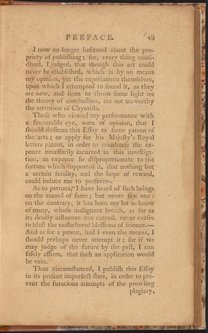An Essay on Combustion : With a View to a New Art of Dying and Painting
The Phlogistic and Antiphlogistic Hypotheses are Proved Erroneous
- 1794

Rights
Download all 201 images
PDFZIPof full-sized JPGsDownload selected image
Small JPG1200 x 1858px — 403 KBLarge JPG2880 x 4458px — 2.4 MBFull-sized JPG3296 x 5102px — 3.0 MBOriginal fileTIFF — 3296 x 5102px — 48.2 MBElizabeth Fulhame was an early British chemist who invented the concept of catalysis and discovered photoreduction. Fulhame’s interest was in the reduction reaction that led to the deposition of metals. As she notes in her preface, “the possibility of making cloths of gold, silver, and other metals by chymical processes, occurred to me in the year 1780; the project being mentioned to Doctor Fulhame and some friends, was deemed improbable. However, after some time, I had the satisfaction of realizing the idea in some degree by experiment.”
This work, An Essay on Combustion relates in great detail her experiments with oxidation-reduction reactions and the conclusions she draws regarding phlogiston theory, in which she disagrees with both the Phlogistians and Antiphlogistians. Phlogiston theory postulated the existence of a fire-like element called phlogiston contained within combustible bodies. Fulhame was made an honorary member of the Philadelphia Chemical Society in 1810 due to her contributions to the field.
| Property | Value |
|---|---|
| Author | |
| Printer | |
| Place of publication | |
| Format | |
| Genre | |
| Extent |
|
| Language | |
| Subject | |
| Rights | Public Domain Mark 1.0 |
| Credit line |
|
Institutional location
| Department | |
|---|---|
| Collection | |
| Physical container |
|
Related Items
-
Oral history interview with Carol W. Greider1993-Sep-22, 1993-Sep-24, 1993-Sep-30, 1993-Oct-05
Cite as
Fulhame, Mrs. (Elizabeth). An Essay on Combustion : With a View to a New Art of Dying and Painting. London, England: J. Cooper, 1794. https://digital.sciencehistory.org/works/42nu42g.
This citation is automatically generated and may contain errors.























































